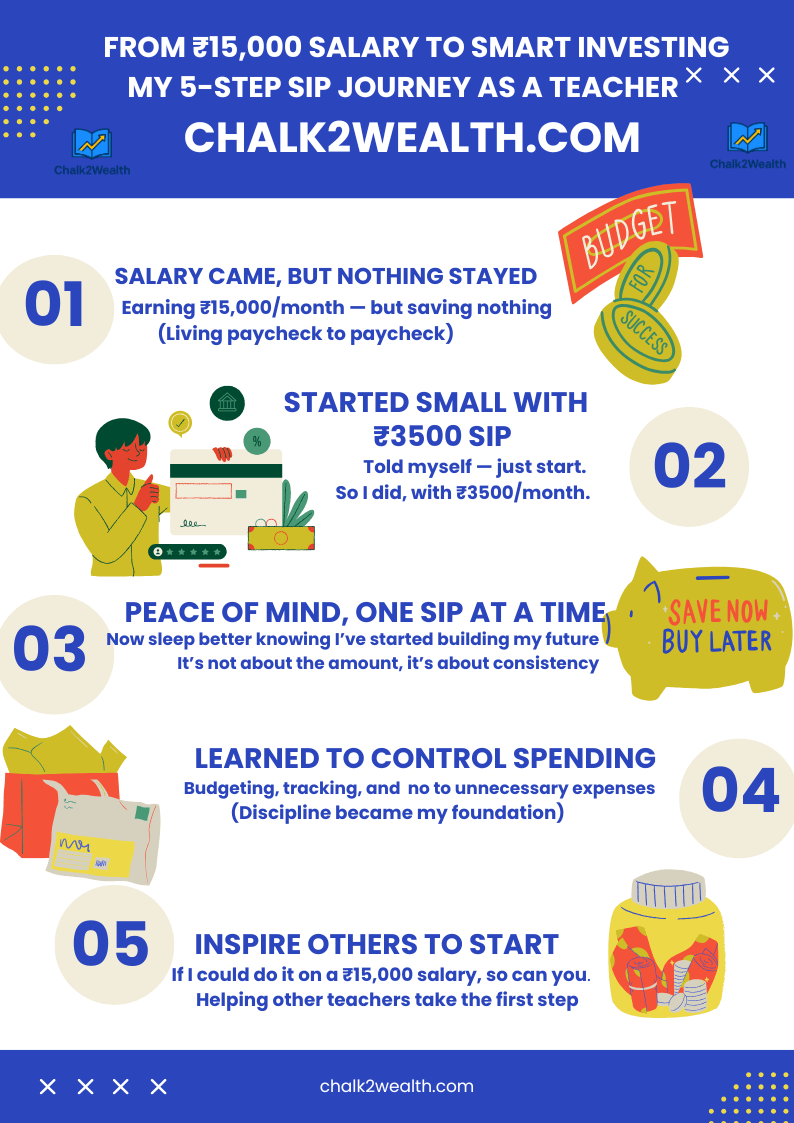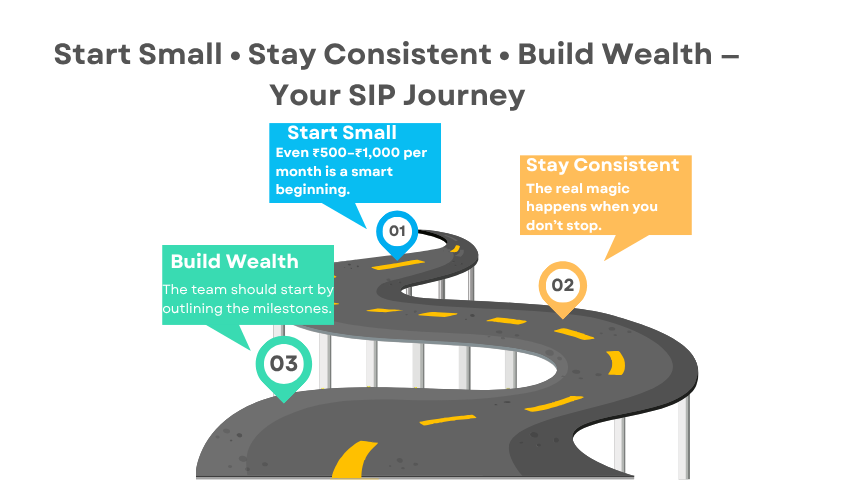Table of Contents
ToggleBest SIP Plans for Teachers: My ₹15,000 Salary Journey to Financial Discipline

By Jagan Charak — School Leader ,Lifelong Learner, and Financial Storyteller
Why Teachers Must Look Beyond Saving — And Find the Best SIP Plans
In 2009, I was a school teacher earning just ₹15,000 per month. Like most teachers around me, my salary vanished quickly — household expenses, children’s education, medical emergencies — the list was endless.
But what was missing in my life was a plan — a plan beyond just saving in a bank or depending on GPF.
That’s when I started searching:
What are the best SIP plans for teachers like me—simple, affordable, and easy to start?
Back then, I didn’t know much about financial markets. I didn’t understand complex charts.
But I knew this: I needed discipline, consistency, and growth that beats inflation.
Starting SIP on a Low Salary — My First Step
After asking around, reading mutual fund brochures, following Value Research fund rankings, and browsing articles in Outlook Money, I carefully shortlisted three SIP plans that were quite popular among teachers and salaried professionals in 2009:
- ICICI Prudential Dynamic Fund
- SBI Magnum Contra Fund
- HDFC Top 200 Fund
These were considered among the best SIP plans for teachers at that time because:
✔️ They consistently featured in Value Research’s recommended funds list.
✔️ Outlook Money’s mutual fund columns highlighted them for their 5-year performance.
✔️ They offered easy monthly SIP options, perfect for small salary investors.
✔️ They were diversified across sectors, which helped reduce risk.
👉 I started with ₹3,500 per month — nearly 25% of my ₹15,000 salary.
It felt like a bold step, but I knew I had to start somewhere.
These weren’t just random picks. I chose them after real research, advice from experienced friends, and tracking recommendations from trusted platforms like Value Research and Outlook Money.
The Moment of Doubt — When I Almost Walked Away
For the next 11 months, I stayed disciplined.
Every month, ₹3,500 quietly left my ₹15,000 salary. It wasn’t easy. Some months felt tighter than others. Unexpected expenses knocked. Family needs came up.
But I kept going. I reminded myself:
“If I stop now, I’ll lose more than money — I’ll lose my habit.”
Still, a storm was brewing.
Around September 2010, the markets dipped. News headlines screamed uncertainty. Some friends told me, “This is risky. You should protect your money.”
The same people who once admired my discipline now questioned my decision.
I began doubting myself.
👉 I logged into my mutual fund account. I clicked “redeem.”
👉 I withdrew everything I had built.
All my patience, all my effort — gone in a few clicks.
Except for ₹11,000 that I accidentally left in one of the funds.
At that moment, I convinced myself: “I’m playing it safe.”
But somewhere deep inside, a quiet voice whispered:
“You just gave up too soon.”

The Forgotten ₹11,000 That Taught Me More Than Any Book
Fast forward to June 2018.
One ordinary evening, I was checking my investment statements — and there it was.
The forgotten ₹11,000 had quietly grown to ₹77,000.
No extra effort. No additional investment.
👉 Just time and compounding — working silently while I moved on.
I sat there for a long time.
Not because ₹77,000 was a huge number. But because it made me realise what I had truly lost — the growth that could have happened if I had continued.
That ₹11,000 taught me something no expert, no article, no classroom ever did:
👉 Compounding does not need our fear. It only needs our patience.
What If I Had Stayed? — My Chalk2Wealth Reflection
I did a simple calculation. If I had continued investing ₹3,500 per month from 2009 to 2018 — just 9 years — my corpus would have easily crossed ₹6 lakh.
If I had continued till today, it could have grown to ₹15-20 lakh or more.
👉 I stopped too early.
👉 I sold out of fear.
👉 I broke my own promise.
The best SIP plans for teachers can only work if we let them.
👉 Your SIP doesn’t need your attention every day. It just needs your permission to stay.
The Mistake That Taught Me More Than Returns Ever Could
I withdrew too early. I lost patience.
And that mistake cost me far more than just money — it cost me time, growth, and the chance to be much further ahead.
Yes, I eventually gathered the courage to start again.
👉 I restarted my SIPs and, over time, I’ve managed to build a respectable corpus.
Today, I feel more secure, more stable, and more confident about my financial future.
But if I’m honest —
That ₹11,000 growing into ₹77,000 became a quiet but painful reminder of what I truly lost.
❝Had I stayed invested from the beginning, continued those ₹3,500 SIPs, and let time do its silent magic…
my portfolio today would have been worth lakhs more.❞
If You’re a Teacher — Please Don’t Wait
Whether you earn ₹15,000, ₹30,000, or ₹80,000 — please don’t wait for the so-called “perfect time” to start investing.
👉 In investing, the perfect time is always in the past.
👉 The next best time is right now — today.
We often wait for salary hikes, bonus seasons, or “when things settle down” to start. But life never really settles. Expenses keep coming, emergencies don’t wait, and opportunities don’t send invitations.
👉 What makes the difference is not when you start — but that you start.
Start small. Start imperfect. Start even if you don’t fully understand everything today.
Stay consistent. Trust the process. Let compounding do its quiet work.
Even if you begin with just ₹500 per month, that first step will change the way you think about money.
👉 What matters is not how much you start with — what matters is that you begin and that you stay.
Because your money needs time, not timing.
My Recommended Best SIP Plans for Teachers (2025)
If I were starting today, I would invest in these top-rated SIP plans for teachers, selected based on Value Research, Morningstar ratings, and personal experience.
| Mutual Fund Name | Category | Morningstar Rating | Value Research Rating |
|---|---|---|---|
| Parag Parikh Flexi Cap Fund (Direct-G) | Flexi Cap | ★★★★★ | ★★★★★ |
| ICICI Prudential Value Fund (Direct-G) | Value | ★★★★★ | ★★★★★ |
| Nippon India Multi Cap Fund (Direct-G) | Multi Cap | ★★★★☆ | ★★★★★ |
| Kotak Large & Midcap Fund (Direct-G) | Large & Midcap | ★★★★☆ | ★★★★☆ |
| SBI Contra Fund (Direct-G) | Contra | — (Not Rated) | ★★★★★ |
(As per the latest available ratings from Value Research and Morningstar in 2025)
👉 You can also check these funds’ CRISIL rankings on the CRISIL official website for additional rating verification.
Why These Are Among the Best SIP Plans for Teachers

- Parag Parikh Flexi Cap: Flexible, globally diversified, and a personal core holding in my portfolio.
- ICICI Prudential Value Fund: Strong value strategy; I’ve trusted it since my SIP restart.
- Nippon India Multi Cap Fund: Balanced exposure across market caps; I continue investing in it.
- Kotak Large & Midcap Fund: A solid combination of stability and growth; recently added to my SIP list.
- SBI Contra Fund: Highly rated by Value Research with a proven contrarian approach; also part of my current portfolio.
SIP Selection Checklist for Teachers (My Simple Rules)
✔️ Always go for funds with at least 4-star ratings on Value Research and Morningstar.
✔️ Double-check CRISIL rankings to feel fully confident about your choice.
✔️ Pick funds that have a solid 5 to 10-year performance history — not just last year’s hype.
✔️ Make sure the fund is diversified — don’t put all your eggs in one basket.
✔️ Stick to funds with low or reasonable expense ratios — why pay extra when you don’t have to?
Chalk2Wealth Final Tip:
👉 The best SIP plans for teachers work only if you stay consistent.
Don’t overthink. Start today. Stay steady. Let your SIP build your wealth — quietly and powerfully.
Best SIP Plans for Teachers – FAQs You Must Know
1. Which SIP scheme is best?
There’s no one-size-fits-all SIP scheme. Here’s a quick guide:
- Short-Term (1–3 years), Low Risk, Goal: Capital Protection
👉 Liquid Funds or Ultra Short-Term Debt Funds - Medium-Term (3–5 years), Moderate Risk, Goal: Balanced Growth
👉 Hybrid Funds (Balanced Advantage or Aggressive Hybrid) - Long-Term (5+ years), High Risk, Goal: Wealth Creation
👉 Equity Mutual Funds (Flexi Cap, Index Funds, Large & Mid Cap)
For Teachers:
Start with Aggressive Hybrid Funds if you’re a beginner. Shift to Flexi Cap Funds for long-term wealth building.
2. Can I invest 1000 ₹ per month in SIP?
Yes, absolutely! You can start a SIP with as little as ₹500 or ₹1,000 per month in most mutual funds. It’s a great option for teachers and salaried professionals with limited starting budgets. Even a small, regular investment can grow into a significant corpus over time due to the power of compounding.
📊 Example: SIP Growth Calculation
If you invest ₹1,000 per month in SIP:
| Investment Duration | Expected Annual Return | Maturity Value |
|---|---|---|
| 25 Years | 12% | ₹27,56,561 |
| 30 Years | 15% | ₹56,31,770 |
👉 Such returns are fairly achievable in mid-cap and small-cap mutual funds over the long term, provided you stay invested and ride out market volatility.
✅ Key Takeaway:
Start small. Stay consistent. SIPs don’t need big amounts — they need time, patience, and
3.Which SIP gives 15% return?
Mutual Funds Delivering 15%+ Annual Returns (2024–25)
As of mid-2025, several equity funds have consistently delivered 15%+ CAGR across 3, 5, and 7-year horizons—backed by Value Research and ET MutualFunds analyses
Parag Parikh Flexi Cap Fund: ~16.8% (3‑yr), ~30.3% (5‑yr), ~19.7% (7‑yr)
Quant Flexi Cap, HDFC Flexi Cap: 15%+ across all three durations
Quant Mid‑Cap Fund: ~17.0%, ~36.3%, ~20.4% CAG
Nippon India Small‑Cap Fund: ~20.7%, ~40.6%, ~19.4% CAGR
Motilal Oswal Mid‑Cap Fund: ~27.3% 3-year CAGR
ET MutualFunds’ -Top 10 to invest (April/June 2025)” include high-performers with 15%+ returns:
Canara Robeco Bluechip, Mirae Large Cap, Parag Parikh Flexi Cap, UTI Flexi Cap, Axis Midcap, Kotak Emerging Equity, Axis Small Cap, SBI Small Cap, SBI Equity Hybrid, Mirae Asset Hybrid Equity
Small‑Cap Surge in 2024:
Small-cap funds delivered even ~26.4% in 2024, indicating strong returns into 2025
 Summary for Chalk2Wealth Readers
Summary for Chalk2Wealth Readers
| Fund Category | Investment Horizon | Historical CAGR | Risk Level |
|---|---|---|---|
| Flexi Cap | 5+ years | 15–30% | Moderate–High |
| Mid‑Cap | 5–7+ years | 15–35%+ | High |
| Small‑Cap | 5–7+ years | 20–40%+ | Very High |
 Key Takeaways for Teachers & Long-Term Investors:
Key Takeaways for Teachers & Long-Term Investors:
These funds—especially Flexi Cap, Mid‑Cap, and Small‑Cap—have realised 15%+ CAGR since 2024.
Good for 5+ year SIPs, with the caveat of high volatility.
All funds are highly rated on Value Research/Morningstar and featured in CRISIL and ET MutualFunds’s top lists.
If you’d like, I can help shortlist 3–5 SIPs that align with your risk profile, or create a portfolio mix tailored to long-term goals. Let me know!
4.Can I withdraw SIP anytime?
Yes, you can withdraw your SIP anytime if you are investing in open-ended mutual funds.
There is no lock-in period in most equity mutual funds unless it’s an ELSS (Equity Linked Savings Scheme), which has a 3-year lock-in.
👉 Key Points:
- Regular SIP (Open-ended fund): You can withdraw anytime without penalty.
- ELSS Funds: You can withdraw after 3 years from each SIP installment.
- Exit Load: Some funds may charge a small exit load if you withdraw within 1 year.
💡 Tip: Always check your fund’s exit load and tax implications before withdrawing.
5.What is the 5 finger rule in SIP?
The 5 Finger Rule in SIP — The Power of a Financial Punch
The 5 Finger Rule in SIP is not just an investment guideline — it’s your financial punch. Just like a hand needs all five fingers to make a strong fist, your SIP journey needs balance across these five pillars:
👊 The Financial Punch – Five Fingers Together:
- Thumb – Living Expenses (Emergency Fund)
👉 Before you throw a punch, you need stability. Keep 3-6 months of expenses ready for emergencies. - Index Finger – Insurance
👉 Pointing toward protection. Always secure your family with proper health and term insurance. - Middle Finger – SIP for Long-Term Growth
👉 The strongest finger stands for your wealth engine — SIP consistently for 5 years or more. - Ring Finger – Goal-Based SIPs
👉 Symbolizing commitment. Start separate SIPs for each life goal like children’s education, home, and retirement. - Little Finger – Flexibility
👉 Never ignore this small but vital part. Keep space to adjust SIP amounts or pause during tough times.
✅ Why It Matters for Teachers & Salaried Professionals:
When all five fingers work together, you build a strong, balanced, and resilient portfolio —
👉 Living expenses secured, insurance covered, long-term wealth growing, life goals funded, and flexibility intact.
That’s the power of a financial punch.
And that’s the true spirit of the 5 Finger Rule in SIP.
✔️ More Financial Stories
How I went From Staffroom struggles to smart budgeting-my true story.
Ready to Start Your SIP Journey? Let’s Make It Simple.
👉 Whether your salary is ₹15,000 or ₹80,000 — what matters is that you start.
👉 The best SIP plans for teachers won’t work if you don’t take that first step.
Need help choosing the right SIP for you?
Message me on WhatsApp — I’m here to guide you, teacher to teacher.


